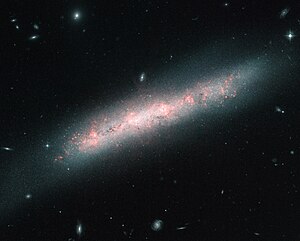NGC 4700
| Galaxie NGC 4700 | |
|---|---|
 | |
| Aufnahme des Hubble-Weltraumteleskops. In den rötlich leuchtenden Hα-Gebieten findet eine aktive Sternentstehung statt. | |
| AladinLite | |
| Sternbild | Jungfrau |
| Position Äquinoktium: J2000.0, Epoche: J2000.0 | |
| Rektaszension | 12h 49m 08,1s[1] |
| Deklination | −11° 24′ 35″[1] |
| Erscheinungsbild | |
| Morphologischer Typ | SB(s)c? / HII / Sy2[1] |
| Helligkeit (visuell) | 12,1 mag[2] |
| Helligkeit (B-Band) | 12,8 mag[2] |
| Winkelausdehnung | 3,2′ × 0,8′[2] |
| Positionswinkel | 48°[2] |
| Flächenhelligkeit | 13,0 mag/arcmin²[2] |
| Physikalische Daten | |
| Zugehörigkeit | NGC 4594-Gruppe LGG 307[1][3] |
| Rotverschiebung | 0.004700 ± 0.000013[1] |
| Radialgeschwindigkeit | (1409 ± 4) km/s[1] |
| Hubbledistanz H0 = 73 km/(s • Mpc) | (58 ± 4) · 106 Lj (17,7 ± 1,2) Mpc [1] |
| Geschichte | |
| Entdeckung | William Herschel |
| Entdeckungsdatum | 25. März 1786 |
| Katalogbezeichnungen | |
| NGC 4700 • PGC 43330 • MCG -02-33-013 • IRAS 12465-1108 • 2MASX J12490814-1124354 • GC 3230 • H III 524 • h 1438 • h 3426 • HIPASS J1249-11 • LDCE 904 NED255 | |
NGC 4700 ist eine aktive Balken-Spiralgalaxie mit ausgedehnten Sternentstehungsgebieten vom Hubble-Typ SBc im Sternbild Jungfrau nördlich der Ekliptik. Sie ist schätzungsweise 58 Millionen Lichtjahre von der Milchstraße entfernt und hat einen Durchmesser von etwa 60.000 Lichtjahren.
Im selben Himmelsareal befinden sich u. a. die Galaxien NGC 4680 und NGC 4708.
Das Objekt wurde im März 1786 von William Herschel entdeckt und als “very faint nebula” beschrieben.[4]
Weblinks
- astronews.com: Bild des Tages 23. Juli 2012
- SIMBAD Astronomical Database
- A galaxy festooned with stellar nurseries (engl.)
Einzelnachweise
Auf dieser Seite verwendete Medien
Autor/Urheber: ESA/Hubble & NASA, Lizenz: CC BY 3.0
The galaxy NGC 4700 bears the signs of the vigorous birth of many new stars in this image captured by the NASA/ESA Hubble Space Telescope.
The many bright, pinkish clouds in NGC 4700 are known as H II regions, where intense ultraviolet light from hot young stars is causing nearby hydrogen gas to glow. H II regions often come part-and-parcel with the vast molecular clouds that spawn fresh stars, thus giving rise to the locally ionised gas.
In 1610, French astronomer Nicolas-Claude Fabri de Peiresc peered through a telescope and found what turned out to be the first H II region on record: the Orion Nebula, located relatively close to our Solar System here in the Milky Way. Astronomers study these regions throughout the Milky Way and those easily seen in other galaxies to gauge the chemical makeup of cosmic environments and their influence on the formation of stars.
NGC 4700 was discovered back in March 1786 by the British astronomer William Herschel who noted it as a “very faint nebula”. NGC 4700, along with many other relatively close galaxies, is found in the constellation of Virgo (The Virgin) and is classified as a barred spiral galaxy, similar in structure to the Milky Way. It lies about 50 million light-years from us and is moving away from us at about 1400 km/second due to the expansion of the Universe.